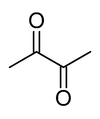- Diketone
-
A diketone is a molecule containing two ketone groups. The simpliest diketone is diacetyl, also known as 2,3-butanedione. Diacetyl, acetylacetone, and hexane-2,5-dione are examples of 1,2-, 1,3-, and 1,4-diketones, respectively. Dimedone is an example of a cyclic diketone.
Reactions
1,3-Diketones, such as acetylacetone, are particularly prone to form stable enols or enolates because of conjugation of the enol or enolate with the other carbonyl group, and the stability gained in forming a six-membered ring, (hydrogen bonded in the case of the enol or containing the counter ion in the case of the enolate).
The conjugate base derived from 1,3-ketones form complexes with metal ions.
Diketones with one or two methylene groups separating the carbonyl groups typically coexist with their enol tautomers. The reactions of such dicarbonyls are very similar to those of simple ketones.
In the DeMayo reaction 1,3-diketones react with alkenes in a photochemical pericyclic reaction to form (substituted) 1,5-diketones.
EU Regulation
In 2004, the EU conducted an examination of certain flavoring additives grouped together as "Flavouring Group Evaluation FGE.11". This group included diketones.[1] As part of that study, the EU found that acetylacetone (pentane-2,4-dione) (FL 07.191) was genotoxic in vivo and in vitro, and deleted it from the register of permitted flavoring substances.[2] The register of permitted flavoring substances was adopted in 1999.[3]
References
- ^ Opinion of the Scientific Panel on Food Additives, Flavourings, Processing Aids and Materials in contact with Food, EFSA Journal (2004) 166, 1-44
- ^ COMMISSION DECISION of 18 May 2005 amending Decision 1999/217/EC as regards the register of flavouring substances used in or on foodstuffs, Official Journal of the European Union
- ^ Official Journal of the European Communities
Categories:- Ketones
Wikimedia Foundation. 2010.


